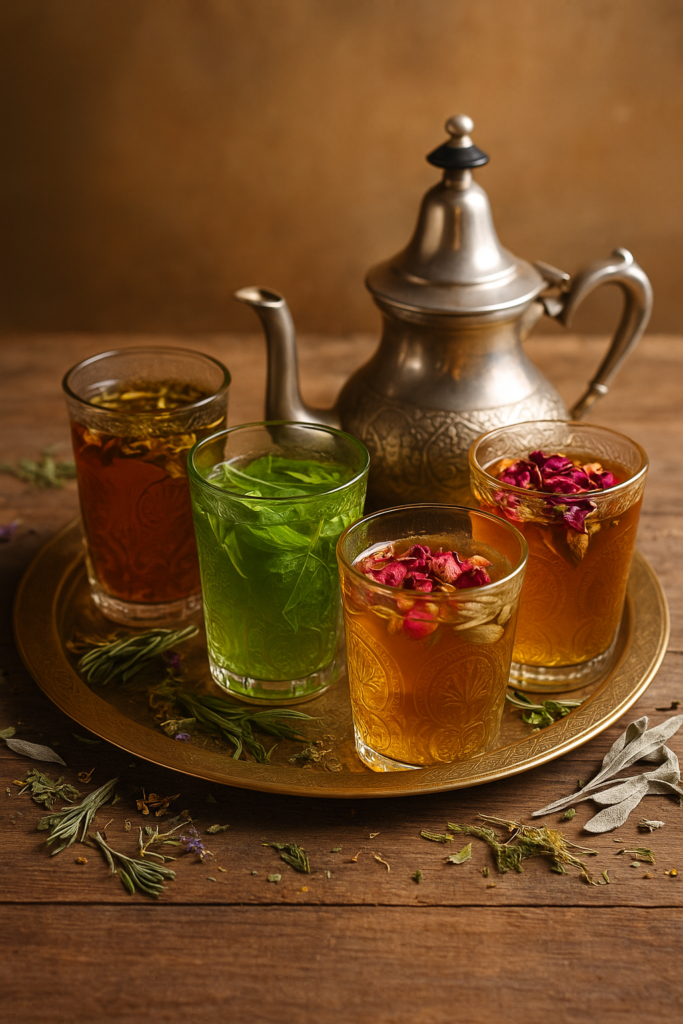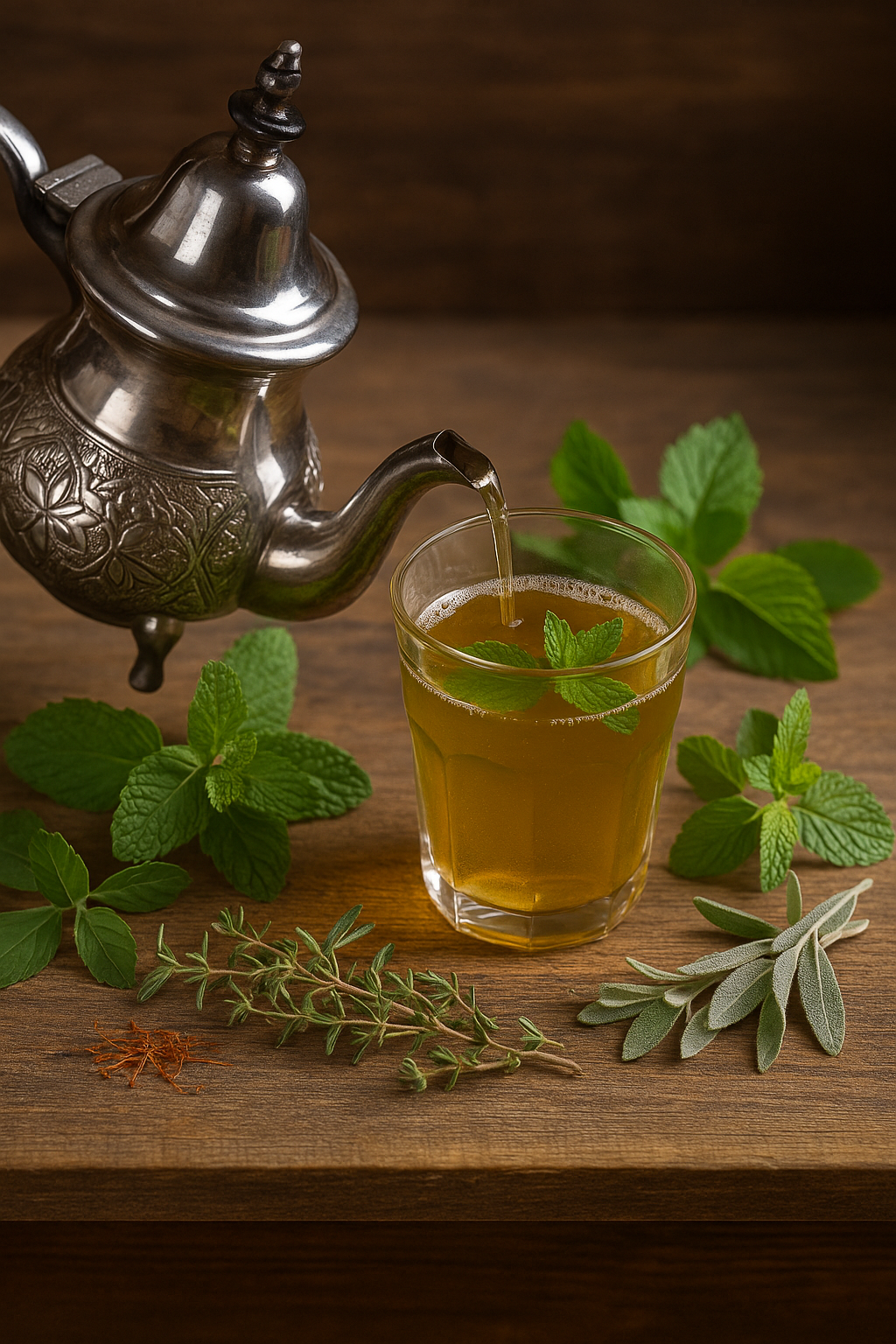Moroccan tea, known locally as Atay, is more than a beverage—it’s a tradition, a gesture of hospitality, and a symbol of Moroccan identity. While the classic green tea with fresh mint is globally recognized, the variations of Moroccan tea with herbs are equally cherished across the country, especially during Ramadan and family gatherings.
This guide takes you beyond mint, exploring regional blends, seasonal flavors, and herbs that bring unique aroma, taste, and even medicinal value to the tea pot.

Moroccan Tea + Herbal Blends: A Cultural Ritual
Tea in Morocco is often served at least three times a day, and it’s the heart of any social encounter. The base of traditional Atay is Chinese gunpowder green tea, which is then infused with ingredients like fresh mint, sugar, and boiling water. But in regions such as Fez, the Rif Mountains, and Marrakech, you’ll find a stunning range of Moroccan herbal tea recipes that go well beyond mint.
Herbs are not only added for flavor but also to aid digestion, cool the body in hot weather, or provide warmth and healing in winter. Let’s explore the base and build from there.
The Base: Traditional Moroccan Mint Tea
To master Atay, you must first understand the foundation. Here’s the essential recipe:
Ingredients:
- 1 tablespoon of Chinese gunpowder green tea
- 4 cups boiling water
- 1 bunch fresh spearmint (na’na)
- 4-6 teaspoons of sugar (to taste)
Instructions:
- Rinse the green tea in a small amount of boiling water. Swirl and discard this water to remove bitterness.
- Add the tea to a Moroccan teapot.
- Fill the pot with boiling water and let it steep for 2 minutes.
- Add mint and sugar.
- Place the pot over low heat and let it simmer for a few minutes.
- Pour the tea into a glass, then back into the pot a few times to mix.
Now that you’ve mastered the classic, let’s discover how to flavor Moroccan mint tea using beloved herbs.
Louiza + Atay: The Power of Lemon Verbena
Lemon verbena, or louiza, is one of the most popular additions to Moroccan tea. It adds a calming, citrusy aroma and is known for its digestive benefits.
Recipe Tip:
Add a few leaves of fresh or dried louiza to the teapot along with the mint and tea leaves. You can reduce the amount of sugar slightly, as louiza has a naturally sweet fragrance.
Best Occasion:
Perfect after ftour (Ramadan iftar meal) to help settle the stomach.
Internal link suggestion: How to Make Moroccan Atay Tea: A Step-by-Step Guide
Chiba + Green Tea: Bitter & Medicinal
Chiba (also known as absinthe or wormwood) is especially popular in the Atlas regions. It has a strong, bitter taste and is often used for its antiseptic and appetite-stimulating properties.
Recipe Tip:
Use only a pinch of chiba—too much will overpower the tea. Pair it with extra mint or a touch more sugar to balance the bitterness.
Best Occasion:
Ideal in winter or when you need a warming, healing drink.
Thyme + Sage + Atay: Herbal Harmony

Thyme and sage are commonly added to tea in northern Morocco. Thyme adds earthiness, while sage contributes a soothing, almost peppery aroma.
Recipe Tip:
Add a sprig of each herb to your standard Atay base. These herbs blend well with green tea and can be used fresh or dried.
Best Occasion:
Perfect for cold evenings, or paired with Moroccan Ghriba cookies as a light snack.
Internal link suggestion: How to Make Traditional Moroccan Ghriba Cookies
Rose Petals + Atay: Floral Elegance
Dried rose petals are used in some Moroccan cities like Fez to infuse Atay with a romantic, floral note. The petals soften the bitterness of green tea and add visual beauty to the tea pot.
Recipe Tip:
Use dried rose petals sparingly—a teaspoon per pot is enough. Combine with mint or verbena for layered aroma.
Best Occasion:
Served during family celebrations, tea parties, or springtime gatherings.
Seasonal Flavors: Saffron, Cinnamon + More
In cooler months or festive settings like Ramadan, Moroccan families incorporate saffron threads, cinnamon sticks, or even ginger slices into their tea.
Flavor Combos:
- Saffron + Mint: Elegant, golden color and subtle floral flavor
- Cinnamon + Verbena: Sweet, spicy, and relaxing
- Ginger + Sage: Great for immunity and warmth
Internal link suggestion: How to Make Traditional Moroccan Harira for Dinner
Flavoring Moroccan Mint Tea + Tips for Ramadan Nights
During Ramadan, Moroccan tea becomes even more central to the family table. After long hours of fasting, Atay is enjoyed slowly and intentionally. Here are some tips:
- Balance sweetness: Mint teas are typically sweetened more generously during Ramadan to restore energy quickly.
- Pair wisely: After Harira soup, a floral or lemony tea like louiza is perfect to calm digestion.
- Use natural herbs for Moroccan tea to replace over-sweetened beverages.
- Prepare in batches and reheat gently—Atay ages well and retains flavor.
Moroccan Tea with Herbs: A Note on Regions
- Fez: Known for louiza and rose petals.
- Rif Mountains: Thyme and sage dominate.
- Marrakech: Bold combinations like mint + absinthe are common.
Each region has its own preference and twist. Embracing these local variations is part of what makes Moroccan tea culture so rich.
Brewing Equipment & Techniques
If you want to brew Moroccan herbal tea like a local:
- Use a Moroccan teapot (barad) with a long spout for proper aeration.
- Steep herbs together with tea, but mind the ratios (especially for strong herbs like chiba).
- Serve in traditional glasses, pouring from a height to aerate and blend.
Multimedia Suggestions
- Embed a YouTube video showing tea preparation from a Moroccan household.
- Link to TikTok clips of traditional tea pouring rituals.
- Feature images of various herbs laid next to a Moroccan teapot, or tea served during a Ramadan ftour.
Conclusion
Whether you enjoy it with mint, louiza, or a bouquet of herbs from the Rif, Moroccan tea with herbs offers endless variations to explore. It’s not just a drink—it’s a journey into Moroccan identity, flavor, and tradition. Embrace the ritual, experiment with combinations, and most importantly, share Atay with loved ones.
Want to dive deeper into Moroccan culinary traditions? Explore our guides on Moroccan Baghrir for Ramadan, Harira, and more.

